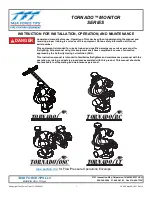
General Information
July 2018
1-2
06-237518-001
1-1.2
Unsuitable Risks
Kidde IGS shall not be used to extinguish fires in:
•
Chemicals containing their own supply of oxygen and which are capable of rapid oxidation
in the absence of air, such as cellulose nitrate or gunpowder
•
Mixtures containing oxidizing materials, such as sodium chlorate or sodium nitrate
•
Chemicals capable of undergoing auto thermal decomposition, such as some organic per-
oxides and hydrazine
•
Reactive metals, such as sodium, potassium, magnesium, titanium, and zirconium
•
Reactive hydrides, or metal amides, some which may react violently with a gaseous extin-
guishant
•
Flammable gas fires such as methane
All of the materials listed above could potentially create the risk of an explosion in a fire.
1-1.3
Fire Class Table
Different standards have different fire classifications. The table below outlines the classifica-
tions for fires based on the various standards.
LOAEL (Lowest Observed Adverse Effects Level) is the lowest concentration at which an
adverse toxicological or physiological effect has been observed in humans. For Kidde IGS
Agents this value is 52%, corresponding to a residual Oxygen concentration of 10% (sea level
equivalent). The human exposure limit is 3 minutes for oxygen level between 10% - 12%.
Note:
The definition of the LOAEL for inert agents differs to that for chemical agents. For inert
gases the LOAEL is based on asphyxiation, the health concern in this instance being the
lowered oxygen concentration.
NOAEL (No Observed Adverse Effects Level) is the highest concentration at which no adverse
toxicological or physiological effect has been observed in humans. For Kidde IGS agents this
value is 43%, corresponding to a residual Oxygen concentration of 12% (sea level equivalent).
The human exposure limit is 5 minutes for oxygen levels of 12% and above.
1-1.4
Technical Limitation
There are, in principle, no technical limitations to Kidde IGS. However, the size of the system
is limited by the space available for storage of the Agent cylinders. Large systems may require
more space in comparison to other solutions. However there is no restriction with regard to
positioning the cylinders horizontally or vertically.
Table 1-1. Fire Classifications
Description
European
Standard
NFPA
Standard
Asia
Combustible materials (wood, paper, fabric, refuse)
Class A
Class A
Class A
Flammable liquids or liquifiable solids
Class B
Class B
Class B
Flammable gas
Class C
Class B
Class C
Flammable metals
Class D
Class D
Class D
Electrical fire
not classified
(formerly Class E)
Class C
Class E
Cooking oils and fats
Class F
Class K
Class F
Summary of Contents for 400 Series
Page 2: ...Table i Revision History Revision Change Description AA Initial Release ...
Page 16: ...July 2018 xiv 06 237518 001 THIS PAGE INTENTIONALLY LEFT BLANK ...
Page 157: ...06 237518 001 A 1 July 2018 APPENDIX A SAFETY DATA SHEETS ...
Page 188: ...July 2018 A 2 06 237518 001 THIS PAGE INTENTIONALLY LEFT BLANK ...
Page 189: ......
















































